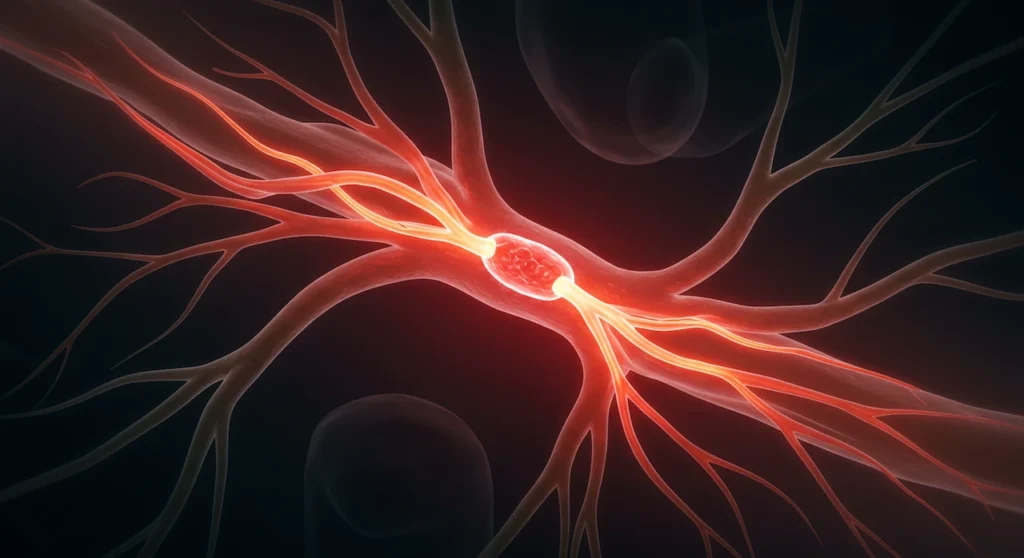Anúncio
That sharp, burning sensation shooting down your leg… the tingling in your fingers that won’t go away… the numbness that creeps in while you’re typing or walking. Sound familiar? If you’re experiencing nerve pain, it’s not random and definitely not something to brush aside. Your body is delivering a powerful message, one that’s often misunderstood or ignored.
Anúncio
And here’s the kicker: the longer you ignore it, the louder and more dangerous the message becomes.

Your Body’s Early Warning System
Nerve pain isn’t merely discomfort. It’s an intelligent, highly evolved alert system that your body uses when something is off-balance, under threat, or breaking down. Unlike a headache or muscle strain that may arise from overuse or tension, nerve pain indicates deeper, often systemic problems. Think of it as a fire alarm in a building—it doesn’t activate because of a mild inconvenience. It goes off when there’s smoke, heat, or fire. That’s exactly what your nervous system does when it senses trouble.
Anúncio
The peripheral nerves—those found outside the brain and spinal cord—are responsible for transmitting signals like temperature, touch, pain, and movement. When these nerves are inflamed, compressed, or damaged, they begin to misfire or underperform. This leads to symptoms such as burning, sharp stabbing sensations, crawling feelings under the skin, electric shocks, or even complete numbness. Importantly, nerve pain is not always constant. It can come and go, intensify with certain activities, or be triggered by seemingly harmless things like brushing against a sheet.
These clues, although subtle, are incredibly specific. And therein lies the importance: your body is not being overly dramatic. It’s precise. Each type of nerve dysfunction presents with a distinct fingerprint of symptoms. This makes early detection possible—if you’re willing to listen. Tragically, many people write off these sensations as “getting older” or “sleeping funny,” missing the opportunity to address the issue early, before permanent damage sets in.
The Silent Conditions Behind the Pain
While nerve pain can result from an obvious injury, like a pinched nerve from a fall or accident, it is more often a stealthy symptom of an underlying chronic condition. What makes this pain particularly deceptive is that it often occurs before any other signs of illness. This is why understanding the root causes is so important—it empowers you to connect the dots before the damage becomes irreversible.
One of the most prevalent causes of chronic nerve pain is diabetes, particularly type 2. Chronically high blood sugar slowly damages small blood vessels that nourish your nerves, especially those in the legs and feet. This leads to a condition called diabetic neuropathy, which begins subtly—with a tingling sensation, occasional numbness, or a pins-and-needles feeling. Over time, this progresses to stabbing or burning pain and eventually can result in complete sensory loss, leading to foot ulcers and infections that don’t heal well.
Vitamin deficiencies, especially vitamin B12, can also quietly erode nerve health. This nutrient is critical for maintaining the myelin sheath that insulates nerve fibers. When it’s lacking, nerves become exposed and misfire. What’s startling is that many older adults, vegetarians, and people on long-term medications like metformin or proton pump inhibitors are at risk for B12 deficiency—and often don’t know it until symptoms like fatigue, balance issues, or nerve pain emerge.
Autoimmune disorders such as lupus, multiple sclerosis (MS), and Sjögren’s syndrome also commonly attack the nervous system. In these conditions, the immune system misidentifies parts of the body—including nerve tissues—as foreign and harmful. This can lead to nerve inflammation, demyelination (loss of the myelin sheath), and eventually impaired nerve signaling.
Thyroid disorders, especially hypothyroidism, can cause nerve entrapment syndromes due to tissue swelling and fluid retention. This explains why people with underactive thyroid glands often experience numbness or tingling in their hands and feet. Chronic infections like shingles, Lyme disease, or even HIV can also directly affect nerve tissues, either through viral invasion or immune system reactions.
Toxic exposure represents another hidden factor. Heavy alcohol use, chemotherapy drugs, and industrial chemicals can gradually poison the nerves, leading to diffuse, hard-to-treat neuropathy. The key takeaway? Many people walk around with one or more of these conditions for years, completely unaware, until their body’s warning system—nerve pain—finally makes the issue impossible to ignore.
When ‘Normal’ Pain Becomes a Red Flag
A sore muscle after a workout or stiffness from poor posture is typical. It resolves with rest, ice, or a hot bath. But nerve pain doesn’t behave this way. It’s persistent, often chronic, and marked by sensations that are abnormal, even disturbing. It may feel like tiny electric zaps, burning beneath the skin, or icy patches that shouldn’t be cold. Importantly, nerve pain tends to follow a “dermatomal pattern”—it tracks along the path of specific nerves or nerve roots. This isn’t random. It’s anatomical.
For instance, sciatica is a textbook example. It often starts in the lower back or buttock and travels down the back of the leg—exactly along the path of the sciatic nerve. Carpal tunnel syndrome involves numbness and tingling in the thumb, index, and middle fingers because that’s where the median nerve runs through the wrist. These precise distributions help doctors pinpoint where the nerve is being irritated or compressed.
A red flag appears when this kind of pain becomes constant, spreads, or starts to interfere with daily activities. Do you drop things more often? Struggle to button shirts or feel pebbles under your feet when walking barefoot? These aren’t minor annoyances—they’re signs that motor and sensory nerves are under duress. And what’s worse, delayed treatment can mean that even if the root cause is corrected later, the nerves may not fully recover.
In some cases, nerve pain is accompanied by autonomic symptoms—changes in sweating, blood pressure irregularities, or gastrointestinal problems. These signals point to deeper involvement of the autonomic nervous system and must be addressed urgently. The longer these red flags are ignored, the greater the risk of permanent nerve injury, disability, and a loss of independence.
The Cost of Waiting Too Long
There’s a dangerous misconception that nerve pain is a passing phase. Many believe if they just give it time, it’ll fade. But unlike muscle or joint pain that may improve with rest, nerve pain often worsens when neglected. This is because nerve damage is cumulative and, in many cases, self-perpetuating. Once a nerve is injured, it can trigger a cycle of inflammation and dysfunction that spreads to neighboring nerves, amplifying the pain.
Take diabetic neuropathy as an example. Left unchecked, it starts in the toes but can gradually work its way up the legs in a pattern known as “stocking distribution.” This isn’t just inconvenient—it’s life-altering. Loss of sensation in the feet increases the risk of unnoticed injuries, which can become infected and lead to amputations. And this is not rare. Thousands of lower-limb amputations are performed each year due to complications from undiagnosed or poorly managed neuropathy.
In another scenario, a herniated disc pressing on a spinal nerve may initially cause mild tingling or pain in the leg. But as the disc degenerates or the inflammation worsens, the nerve may become permanently compressed. This can lead to irreversible weakness, loss of reflexes, and even bowel or bladder dysfunction—a condition known as cauda equina syndrome that requires emergency surgery.
Delaying treatment doesn’t just affect your body—it also affects your quality of life. People with chronic nerve pain often report poor sleep, increased stress, and a reduced ability to enjoy social or physical activities. This can spiral into emotional and psychological distress, including depression and anxiety. And since nerve pain is invisible, patients may struggle to explain their condition to others, leading to isolation and misunderstanding.
In short, the cost of waiting too long is steep—and irreversible in many cases. Listening to your body’s early cues isn’t a luxury. It’s an act of self-preservation.
Your Next Steps: From Pain to Answers
Once nerve pain becomes part of your daily experience, it’s time to take action. But rather than panicking, it helps to approach this process methodically. First, speak with your primary care provider about your symptoms. Bring detailed notes—when the pain started, how it feels, what triggers or eases it, and whether it’s getting worse. This symptom journal becomes a vital tool in identifying patterns and directing further testing.
Your doctor may begin with blood work to screen for common issues like high glucose levels, vitamin deficiencies, liver or kidney problems, or autoimmune markers. Imaging—such as MRIs or CT scans—helps visualize structural problems like disc herniations or nerve entrapments. More specialized tests, like nerve conduction studies and electromyography (EMG), are often used to determine how well electrical signals are traveling through the nerves and muscles. These can help identify whether the issue is sensory, motor, or both.
Sometimes, the path to answers is nonlinear. You may see multiple specialists: neurologists, endocrinologists, rheumatologists, or infectious disease experts. Each brings a different lens to the problem. For this reason, staying organized and proactive in your care is essential. Ask questions. Keep copies of your test results. Don’t be afraid to request a second opinion if something doesn’t feel right.
Alongside this diagnostic workup, supportive care may begin. Physical therapy can help preserve mobility and improve nerve function. Nutritional interventions may address underlying deficiencies. While research into functional ingredients and nerve support nutrients is ongoing, many people include certain B vitamins, alpha-lipoic acid, and magnesium as part of their wellness strategy. These elements are frequently studied for their potential to assist in nerve regeneration and reduce oxidative stress. However, always discuss supplements with your doctor before starting anything new.
Soft Disclaimer: This article provides educational content for informational purposes and does not constitute medical advice. Always consult a licensed healthcare provider before making decisions related to diagnosis or treatment.
Final Thoughts
Nerve pain is not a random occurrence or a minor annoyance—it’s a signal crafted by the most advanced communication system in your body. It speaks clearly, urgently, and with purpose. Whether that message is about high blood sugar, a vitamin deficiency, an inflamed nerve, or something else entirely, ignoring it does not make it go away. In fact, neglecting nerve pain often allows it to grow stronger, more complex, and harder to treat.
But here’s the good news: by tuning in and responding early, you can drastically alter the outcome. Listening to what your nerves are telling you isn’t just about relieving pain—it’s about protecting your long-term health, preserving function, and maintaining independence. With proper evaluation, an informed care plan, and patience, nerve pain can be managed, mitigated, or even reversed in some cases.
You have more control than you think. Pay attention, ask questions, and don’t wait for the pain to become unbearable before seeking help. Your body is speaking. It’s time to listen—and act.
